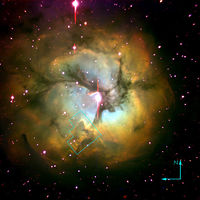Trifid Nebula
 From Conservapedia
From Conservapedia | Trifid nebula | |
|---|---|

| |
| Observational Data | |
| Designation | Messier 20
NGC 6514 |
| Right ascension | 18h 02m 23s |
| Declination | -23° 01′ 48″ |
| Constellation | Sagittarius |
| Type of object | Nebula |
| Dimensions | 28.0' |
| Magnitude | 6.3 |
| Astrometry | |
| Distance from Earth | 5,200 ly |
The Trifid nebula (M20, NGC 6514) is a nebula in the constellation of Sagittarius.[1] Found only 2 degrees from the larger Lagoon nebula, the Trifid nebula is a well known star forming region and houses several different types of nebulae, including: an emission nebula, a reflection nebula, a dark nebula and an open cluster. Its name derives from its three lobes. It is relatively ease to observe through small telescopes and its proximity to the Lagoon nebula makes it a popular target for astronomers. It is best seen from the southern and equatorial regions in late summer.[2] The nebula has often been mentioned in works of science-fiction.
History[edit]
The nebula was first observed by Charles Messier on 5th June 1764 and added it as the 20th item in his catalogue.[3] Specifically, Messier observed the star cluster, describing it as a cluster of stars of the 8th or 8th magnitude. While Messier identified the star cluster and on later inspection some nebulosity surrounding it, it was William Herschel in 1784 who noted there were three different nebulae that combined to form the Trifid nebula. His son, John Herschel, was the first to refer to the nebula as the "Trifid nebula" in 1826.[1] Much later in 1919, Edward Barnard catalogued the dark nebula responsible for the Trifid nebula's distinctive shape as Barnard 85.[1]
Properties and Structure[edit]
The nebula consists of several different types of nebulae. At its centre is a blue open star cluster which is surrounded by a red emission nebula.[3] These hot stars produce large quantities of ultraviolet radiation, ionizing the surrounding hydrogen gas.[4] When the ionzed hydrogen recombine, the distinctive hydrogen alpha red is emitted. This emission nebula is enclosed by a blue reflection nebula, most noticeable in the northern most parts of the nebula. Here, the radiation from the central star cluster is too weak to cause ionization, so instead the blue light of the hot stars is simply reflected off gas and dust. This gives rise to a blue appearance. A dark nebula in the foreground is responsible for the characteristic three lobes. There may also be a supernova remnant in the nebula.[5]
There is large uncertainty in the distance to the Trifid nebula, with some sources putting it as low as 2,200 light years and others at around 9,000 light years.[3] It has a linear diameter of approximately 42 ly and is fairly bright with an apparent magnitude of 6.3 (though some sources suggest it is somewhat fainter at around 9).[6] The Nebula also contains some stellar jets and an evaporating gaseous globule, or EGG.[7]
References[edit]
- ↑ 1.0 1.1 1.2 Trifid nebula from messier-objects.com
- ↑ Messier 20 from freestarcharts.com
- ↑ 3.0 3.1 3.2 M20 from messier.seds.org
- ↑ Trifid, M20, NGC 6514 from the National Optical Astronomy Observatory
- ↑ Radio continuum emission from the central stars of M20 and the detection of a new supernova remnant near M20
- ↑ Trifid nebula from constellation-guide.com
- ↑ Messier 20 from universetoday.com
Categories: [Astronomy] [Nebulae] [Messier Objects]
↧ Download as ZWI file | Last modified: 02/22/2023 03:41:55 | 7 views
☰ Source: https://www.conservapedia.com/Trifid_nebula | License: CC BY-SA 3.0
 ZWI signed:
ZWI signed: KSF
KSF